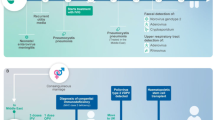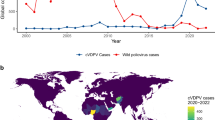Abstract
Despite strong evidence to the contrary1,2,3,4,5, speculation continues that the AIDS virus, human immunodeficiency virus type 1 (HIV-1), may have crossed into humans as a result of contamination of the oral polio vaccine (OPV)6,7,8. This ‘OPV/AIDS theory’ claims that chimpanzees from the vicinity of Stanleyville — now Kisangani in the Democratic Republic of Congo — were the source of a simian immunodeficiency virus (SIVcpz) that was transmitted to humans when chimpanzee tissues were allegedly used in the preparation of OPV6,7. Here we show that SIVcpz is indeed endemic in wild chimpanzees of this region but that the circulating virus is phylogenetically distinct from all strains of HIV-1, providing direct evidence that these chimpanzees were not the source of the human AIDS pandemic.
Similar content being viewed by others
Main
Detection and molecular characterization of SIVcpz in chimpanzee communities in the vicinity of Kisangani should directly test the OPV/AIDS theory. An earlier survey of chimpanzees at Wanie-Rukula near Kisangani (Fig. 1a; W. D. Hamilton, M.W. and J. B. J., January 2000, see ref. 9) failed to identify SIVcpz viral (v) RNA in any of 34 faecal samples collected. However, western immunoblot analysis of 10 chimpanzee urine samples collected at the same time identified two specimens that showed strong crossreactivity with the HIV-1 core protein p24 (Fig. 1b). Such indeterminate urine antibody profiles were found in chimpanzees from Tanzania, where SIVcpz infection was subsequently demonstrated after amplification by polymerase chain reaction (PCR) and sequencing of DNA10.
a, Map of the Democratic Republic of Congo (DRC) and neighbouring countries showing the ranges of Pan troglodytes troglodytes (Ptt) and Pan troglodytes schweinfurthii (Pts). b, Western blot analysis of urine samples from 10 chimpanzees, collected during the 2000 expedition to rainforests near Kisangani; plasma from a positive HIV-1 control is shown in the left lane, with crossreactivity to the different viral proteins indicated. Two samples showed strong crossreactivity with HIV-1 p24 (arrowhead). c, Maximum-likelihood-estimated phylogenetic tree for gp41/nef sequence data, with bootstrap results. Bootstrap percentages are shown for all clades that were present in more than 50% of 1,000 maximum-likelihood-inferred bootstrap trees. Support for the SIVcpzDRC1/SIVcpzTAN clade was very strong (99%). Analysis of partial gag sequences supported the same phylogenetic position for SIVcpzDRC1 (data not shown). For further details of phylogenetic analyses, see supplementary information.
To confirm the existence of SIVcpz in the Kisangani apes and to identify circulating strain(s) at a molecular level, we resumed field-work in February 2003, this time collecting 97 faecal samples from three different sites (for map, see supplementary information). From these, we identified one SIVcpz vRNA-positive specimen from the Parisi forest by PCR amplification of gag (422 base pairs) and gp41/nef (699 base pairs) sequences. This result confirmed that natural SIVcpz infection was present in chimpanzees in the Kisangani region.
Phylogenetic analysis of the newly derived sequences revealed that the Kisangani virus clustered with high statistical support with SIVcpz strains that were infecting chimpanzees of the same subspecies (Pan troglodytes schweinfurthii) that lived about 800 km to the south-east in Gombe National Park in Tanzania10,11. The new virus, which we designate SIVcpzDRC1, represents a third lineage within the well circumscribed P. t. schweinfurthii SIVcpz radiation, and is clearly distinct from the P. t. troglodytes SIVcpz clade that includes all known strains of HIV-1 (Fig. 1c, and see supplementary information).
These results indicate that chimpanzees in the vicinity of Kisangani are endemically infected with SIVcpz that is highly divergent from HIV-1, thereby ruling out these apes as the source of HIV-1 and refuting the OPV/AIDS theory. Instead, each of the many circulating HIV-1 variants comprising groups M, N and O is linked to SIVcpz from P. t. troglodytes (Fig. 1c), the chimpanzee subspecies native to west-central Africa1,12.
Given that fears about the safety of polio vaccines are currently threatening the global campaign to eradicate the disease8, our clear-cut evidence against one of the key sources of concern is timely. The molecular epidemiological data presented here, together with data suggesting that HIV-1 group M originated 30 years before OPV trials were conducted1,13 and the absence of detectable SIVcpz or chimpanzee DNA in archival stocks of OPV2,3, should finally lay the OPV/AIDS theory to rest.
References
Sharp, P. M. et al. Phil. Trans. R. Soc. Lond. B 356, 867–876 (2001).
Blancou, P. et al. Nature 410, 1045–1046 (2001).
Berry, N. et al. Nature 410, 1046–1047 (2001).
Rambaut, A., Robertson, D. L., Pybus, O. G., Peeters, M. & Holmes, E. C. Nature 410, 1047–1048 (2001).
Plotkin, S. A. Phil. Trans. R. Soc. Lond. B 356, 815–823 (2001).
Hooper, E. The River: A Journey Back to the Source of HIV and AIDS (Penguin, London, 1999).
Hooper, E. Atti Conv. Lincei 187, 27–230 (2003).
Butler, D. Nature 428, 109 (2004).
Trivers, R. Nature 404, 828 (2000).
Santiago, M. L. et al. J. Virol. 77, 2233–2242 (2002).
Santiago, M. L. et al. Science 295, 465 (2001).
Gao, F. et al. Nature 397, 436–441 (1999).
Korber, B. et al. Science 288, 1789–1796 (2000).
Author information
Authors and Affiliations
Corresponding author
Ethics declarations
Competing interests
The authors declare no competing financial interests.
Supplementary information
Supplementary Figure
Study locations of wild chimpanzees near Kisangani in the Democratic Republic of Congo. (JPG 42 kb)
Rights and permissions
About this article
Cite this article
Worobey, M., Santiago, M., Keele, B. et al. Contaminated polio vaccine theory refuted. Nature 428, 820 (2004). https://doi.org/10.1038/428820a
Issue Date:
DOI: https://doi.org/10.1038/428820a
This article is cited by
-
Social constructionism and climate science denial
European Journal for Philosophy of Science (2020)
-
Differences in MHC-B diversity and KIR epitopes in two populations of wild chimpanzees
Immunogenetics (2019)
-
MHC class I diversity in chimpanzees and bonobos
Immunogenetics (2017)
-
The History of the HIV/AIDS Epidemic in Africa
Current HIV/AIDS Reports (2016)
-
The Evolution of Resistance to Simian Immunodeficiency Virus (SIV): A Review
International Journal of Primatology (2014)
Comments
By submitting a comment you agree to abide by our Terms and Community Guidelines. If you find something abusive or that does not comply with our terms or guidelines please flag it as inappropriate.




